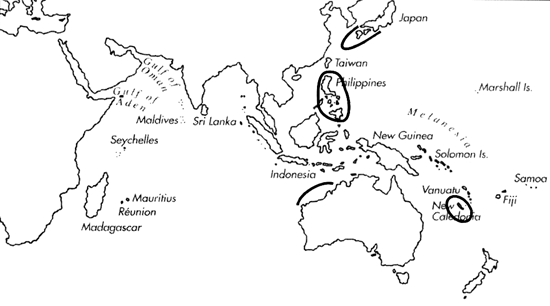
Skip Navigation Links
View access keys for this site.

Range: Japan, Philippines, N. W. Australia, Solomon Is., and New Caledonia; recently reported from Vietnam.
Description: Moderately small to medium-sized and light to moderately solid. Last whorl narrowly conical or conical to usually slightly pyriform; outline straight to slightly convex adapically, straight to slightly concave below. Shoulder sharply angulate to carinate, sometimes also tuberculate, with a rather deep exhalent notch. Spire of moderate height to high, variably stepped; outline concave. Larval shell of about 3.5 whorls, maximum diameter about 1.1 mm; type specimens of C. schepmani with 2.5-3 larval whorls. First 6-9, sometimes all postnuclear whorls tuberculate. Teleoconch sutural ramps concave, with radial threads and 1 increasing to 3-5 spiral grooves, and a few spiral striae in latest whorls. Entire last whorl with regularly spaced punctate spiral grooves separating flat ribbons; in large specimens, spiral sculpture weak on adapical fourth.
| Shell Morphometry | ||
|---|---|---|
| L | 31-50 mm | |
| RW | 0.03-0.15 g/mm | |
| RD | 0.41-0.56 | |
| PMD | 0.78-0.88 | |
| RSH | 0.18-0.26 | |
Ground colour white. Last whorl with 4 spiral rows of brown flecks, often fusing into variably continuous bands, located below shoulder, on both sides of centre and at base. Type specimens of C. schepmani with only 2 bands. Spiral rows of heavily to sparsely developed brown dots and dashes on ribbons of last whorl. Larval whorls white. Postnuclear sutural ramps with scattered to closely set brown radial markings, partially with brown dots at outer margins. Aperture translucent white, occasionally with a brown or violet blotch deep within.
Periostracum brown, thin, translucent.
Radular teeth with an adapical barb opposite 2 barbs in line and a narrow waist distal to the centre of the shaft; no serration but a large spur at base (Rolán, pers. comm., 1992).
Habitat and Habits: In 80-400 m, in sand and coral rubble. The type specimens of C. schepmani were found on "fine and coarse sand".
Discussion: C. ichinoseana is distinguished by its larger size (to 105 mm), straight-sided, often higher spire (RSH 0.23-0.29), usually with larger tubercles, and by the absence of spiral grooves on its sutural ramps. In addition, C. comatosa lacks the 2-3 incised spiral grooves just below the shoulder characteristic of C. ichinoseana and C. orbignyi. C. orbignyi can also be distinguised by its partly to completely tuberculate rather than mostly smooth shoulder and its 3 rather than 4 spiral colour bands on the last whorl. For comparison of C. comatosa with C. saecularis, see the Discussion of the latter species. An extant species, C. comatosa was based on specimens originally thought to date from the Pliocene (ca. 3-5.5 my ago), but they are more likely late Pleistocene, perhaps 25,000 years ago. The synonymy of C. schepmani with C. comatosa remains uncertain (Coomans et al., 1986). The type specimens of C. schepmani are subadult; this growth stage may be responsible for a relatively higher spire (RSH 0.28) and heavier spiral sculpture of the last whorl in comparison with adult specimens of typical C. comatosa. The similarities in shape, colour pattern and sculpture of both last whorl and spire provisionally favour synonymy.

C. comatosa range map
This section contains verbatim reproductions of the accounts of 316 species of Conus from the Indo-Pacific region, from Manual of the Living Conidae, by Röckel, Korn and Kohn (1995). They are reproduced with the kind permission of the present publisher, Conchbooks.
All plates and figures referred to in the text are also in Röckel, Korn & Kohn, 1995. Manual of the Living Conidae Vol. 1: Indo-Pacific Region.
The range maps have been modified so that each species account has it own map, rather than one map that showed the ranges of several species in the original work. This was necessary because each species account is on a separate page on the website and not confined to the order of accounts in the book.
Return to framed version (returns to search page)